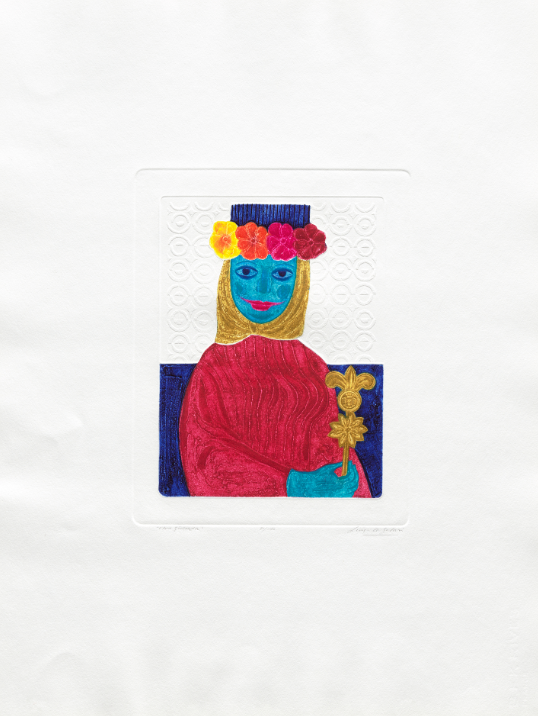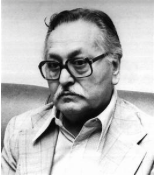

Luis Alberto Solari (n. Fray Bentos, on October 17, 1918 – October 13, 1993) was a painter and engraver from Uruguay, In 1925, his family moved to the country’s capital, Montevideo, where he came into sporadic contact with painting and its techniques. In 1932 he met the painter Zoma Baitler, and a year later he joined the Decorative Painting Workshop given at the Escuela Industrial by professor Guillermo Laborde. There, in collaboration with other students, he did stage sets, scenography, and building decoration with large format mural paintings. He began showing professionally at an exhibition of the National Painting, Drawing and Print Salon of Montevideo. In 1941, he received his first major award, the Acquisition Prize at the Municipal Plastic Arts Salon.
In 1948, he began a fundamental stage of his career, taking the carnival as a theme for his work. In Paris he became involved with the Jeune Gravure Contemporaine group. The sculptor Osip Zadkine introduced him, in turn, to the Print Workshop at L’Ecole Superièure de Beaux Arts, directed by the master Edouard Goerg, where he began etching. He also did studies from life at the Grand Chaumière. He saw firsthand the work of masters like Titian and Brueghel, or more recent ones, like Ensor, Klee, Rouault, and one of his favorites, Gauguin. But what most impressed him was the Renaissance painting of the Quattrocento: Van Eyck, Bosch, Dürer, and others.
Amongst Solari’s many prizes and distinctions were first prizes for drawing at the Salon Nacional de Bellas Artes in Montevideo in 1955 and 1964, the first prize for painting there in 1965 and the gold medal for printmaking at the first Bienal de Artes Graficos in Cali, in 1977. In 1989, the Museo Luis Alberto Solari opened in the city of Fray Bentos, Uruguay, showing his works and promoting fine arts in the region.
In 1992 a jury appointed by the Ministry of Education and Culture granted him the Plastic Arts Lifetime Achievement Award.
Luis Alberto Solari – La Otra Gioconda (The Other Mona Lisa) Aguafuerte con intaglio/etching with intaglio
Luis Alberto Solari (n. Fray Bentos, del 17 de octubre de 1918 al 13 de octubre de 1993) fue un pintor y grabador uruguayo. En 1925 su familia se mudó a la capital del país, Montevideo, donde entró en contacto esporádico con la pintura y sus técnicas. En 1932 conoció a la pintora Zoma Baitler, y un año después se unió al Taller de Pintura Decorativa impartido en la Escuela Industrial por el profesor Guillermo Laborde. Allí, en colaboración con otros estudiantes, realizó escenografías, escenografía y decoración de edificios con pinturas murales de gran formato. Comenzó a mostrar profesionalmente en una exposición del Salón Nacional de Pintura, Dibujo e Impresión de Montevideo. En 1941 recibió su primer gran premio, el Premio de Adquisición en el Salón Municipal de Artes Plásticas.
En 1948 comenzó una etapa fundamental de su carrera, tomando el carnaval como tema para su trabajo. En París se involucró con el grupo Jeune Gravure Contemporaine. El escultor Osip Zadkine lo presentó, a su vez, en el Taller de impresión en L’Ecole Superièure de Beaux Arts, dirigido por el maestro Edouard Goerg, donde comenzó a grabar. También hizo estudios de la vida en el Grand Chaumière. Vio de primera mano la obra de maestros como Tiziano y Brueghel, o más recientes, como Ensor, Klee, Rouault y uno de sus favoritos, Gauguin. Pero lo que más le impresionó fue la pintura renacentista del Quattrocento: Van Eyck, Bosch, Durero y otros.
Entre los muchos premios y distinciones de Solari, se encuentran los primeros premios de dibujo en el Salón Nacional de Bellas Artes de Montevideo en 1955 y 1964, el primer premio de pintura allí en 1965 y la medalla de oro para el grabado en la primera Bienal de Artes Gráficas de Cali, en California. 1977. En 1989 se inauguró el Museo Luis Alberto Solari en la ciudad de Fray Bentos, Uruguay, mostrando sus obras y promoviendo las bellas artes en la región.
En 1992, un jurado designado por el Ministerio de Educación y Cultura le otorgó el Premio a la Trayectoria en Artes Plásticas.
